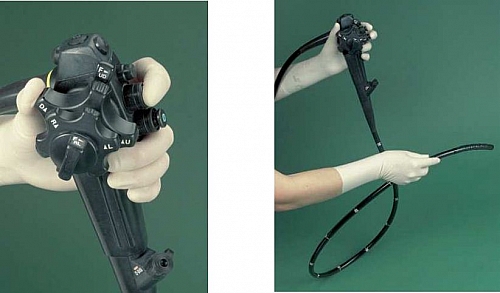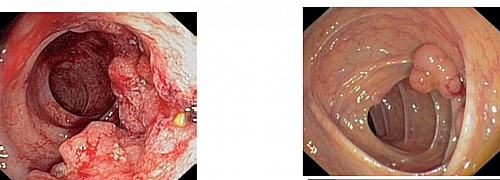Table of Contents
- What is a Colonoscopy?
- Colonoscopy preparation instructions for patients
- Tips on How to prepare for colonoscopy
- Parts of a Colonoscopy scope (Colonoscope)
- Some Accessories Parts used with a Colonoscope
- Bowel Preparation for Colonoscopy
- After colonoscopy
- Colonoscopy results interpretation
- How long does a colonoscopy take?
- Reasons for colonoscopy procedure
- Types of Colonoscopy
- Indications or Reasons for Colonoscopy procedure
- Contraindications to Colonoscopy
- Complications/Side effects of Colonoscopy
What is a Colonoscopy?
Colonoscopy is a procedure used both for diagnosis and therapy of diseases affecting the colon in which the whole colon is visualized using an endoscope known as a colonoscope. The colonoscope has a long flexible tube that is approximately the size of the finger of an adult. The length of the scope is about 125 cm to 183 cm long.
Colonoscopy is also effective in diagnosing even small lesions measuring less than 1 cm, mucosal lesions and some submucosal conditions such as colitis and angiodysplasia. While barium enema is only used as a diagnostic tool, the colonoscope can take biopsy, remove polyps, ablate, dilate, and even at times stop the intestinal bleeding (hemostasis). Barium enema, being more universally available and less costly than Colonoscopy and requiring less vigorous patient preparation and perhaps safer than Colonoscopy, is still frequently used.
Colonoscopy still needs to be complemented because of potential blind spots (at flexures, for example) and occasionally the cecum cannot be intubated; hence, contrast radiography may be required. However, barium enema is less useful in the rectosigmoid colon because the presence of diverticulosis and overlapping folds can lead to some lesions not being seen.
Colonoscopy preparation instructions for patients
- The Colonoscopy procedure is explained to the patient
- An informed consent is obtained by explaining the benefits, risks, complications and cost of doing the procedure to the patient and getting the patient to sign the consent form.
- Bowel prep is then done. See details below.
- Intravenous fluids are given
- Appropriate Sedation and medications are administered to reduce pains during colonoscopy and helps in muscle relaxation
- Positioning: the patient is then positioned appropriately
Tips on How to prepare for colonoscopy
- If you are taking any drug for any other disease, you should let your doctor know
- If you are allergic to any drug, also let the doctor know
- Drugs such as Aspirin or other blood thinners may cause you to easily bleed during colonoscopy, hence let your doctor know about it too. Your doctor may suggest stopping the aspirin for about 7 to 14 days before the colonoscopy test.
- If you think you are pregnant, make sure it is confirmed.
- You will stop eating solid food about 2 days before the colonoscopy test in other to empty the intestines of food before the test. During this two day period, you will be taking fluids such as tea, pap or juice.
- When your doctor gives you the laxative, you will notice an increase in your bowel habit; hence you need to stay at home because you will use the toilet often.
- You will have to stop drinking fluid about 8 hours prior to the colonoscopy test
Parts of a Colonoscopy scope (Colonoscope)
- Universal cord
- Control head
- Insertion tube
- Air/water spray nozzle
- Lens
- Light channels
- Biopsy channel
Some Accessories Parts used with a Colonoscope
- Biopsy forceps for taking biopsy of tissue for histology
- Clip applicator
- Injection needle
- Polypectomy snare
- Retrieval devices (baskets or graspers)
- Cytology brushes
- At least a Monopolar cautery device
Bowel Preparation for Colonoscopy
Adequate mechanical bowel preparation is required before colonoscopy and this is efficiently obtained with rapid gut lavage by ingestion of a polyethylene glycol electrolyte lavage solution (CoLyte). This is the commonest physiologic preparation and it does not require enemas. This type of preparation can be done within a few hours prior to the Colonoscopy procedure. Other commonly used types of bowel preparation in Colonoscopy include the use of saline cathartics and enemas or Intravenous narcotics and sedative; but many patients may undergo the Colonoscopy procedure without any medication.
The patient is monitored during the bowel preparation with pulse oximetry to check the level of oxygenation of the lungs and sphygmomanometry to ascertain the blood pressure, these help to check if there is any cardiopulmonary compromise. Electrocardiography may be used when indicated.
How is a Colonoscopy performed? Colonoscopy Procedure
- A Colonoscopy is performed following proper bowel preparation of the patient.
- The patient is usually placed in the left lateral recumbent position. The region around the anus (perianal area) is then examined.
- Rectal examination is then performed, and the colonoscope is inserted.
- Once the rectum has been intubated, a small amount of air is inflated to visualize the lumen and the instrument is progressively advanced with the right hand, the tip being deflected with the controls of the left hand.
- Advancement involves not only forward insertion of the instrument but also combinations of jiggling the instrument to and fro and any motion that will permit telescoping of the bowel over the endoscope.
- The main reason of insertion is to achieve adequate intubation desired as efficiently as possible.
- Careful inspection is made on withdrawal of the endoscope. The landmarks on reaching the cecum include visualization of the ileocecal valve and the appendiceal orifice.
- Obstacles to reaching the cecum include poor preparation, strictures, large tumors, and inability to straighten the sigmoid as from previous pelvic operations, radiation or sometimes from extensive diverticular disease.
After colonoscopy
- You may have to stay for about 2 hours for observation before you go home
- You will be told by your doctor when to start eating
- You should avoid taking alcohol immediately after a colonoscopy test
- Drink much fluid after colonoscopy in order to replace lost fluids during the procedure
- The side effects of the sedatives may last for about day. During this period, do not drive or operate any machine and do not sign any document as you may not think clearly.
Colonoscopy results interpretation
If no biopsy was taken during colonoscopy, your doctor will tell you the result immediately of their findings such as if there is bleeding, polyps or tumors. If biopsies are taken, then you have to come back after few days to collect the results. The tissue will be sent to the laboratory to check whether it is malignant or not.
What can affect colonoscopy test results?
- Having a barium enema about 7 days to the test blocks the view of the colon mucosa
- Failure to adhere to colonoscopy prep instructions makes some fecal matter to still remain in the colon during the colonoscopy test and this blocks the view
- Taking iron supplements before the test makes it difficult to completely clean the colon during colonoscopy prep.
How long does a colonoscopy take?
Colonoscopy requires manual dexterity and concentration and when done properly, the Caecum is reached in 98% of patients by experienced doctors. Some conditions may cause difficulty during Colonoscopy and may take longer to view the colon, such conditions include: mobile or elongated sigmoid/transverse colon, postoperative intestinal fixations and other adhesions. In the absence of these difficulties, Colonoscopy generally takes about 30 minutes to examine the colon, rapid advancement and inspection up to caecum is desirable, considering the discomfort that Colonoscopy causes to the patient; but Careful examination of all colon segments when withdrawing the colonoscope is essential for thorough examination.
For the proper performance of colonoscopy procedure, especially when used in treatment, it is important to have additional instruments that will aid treatment. There are advanced Colonoscopes that are fiber optic or video instruments. Features of the video colonoscope that make it advanced include: ability to interact with computers to generate reports, scheduling, maintaining databases and clear image display. Not less than 160cm of working length is desirable and an instrument channel of at least 3.7 mm in diameter. Other accessories are mentioned below.
Reasons for colonoscopy procedure
- Colonoscopy is use to investigate rectal bleeding: when you are bleeding from your rectum, Colonoscopy can be done for you in order to know the exact source of the bleeding.
- Colonoscopy can also be used for detecting polyps in the colon or for removal of polyps, a procedure referred to as Polypectomy. If colonic strictures prevent passage of the colonoscopy tube, a Barium Enema is used; however, Barium Enema is mostly used to investigate a change in bowel habit.
In general, Colonoscopy helps in good visualization of the whole length of the colon, rectum and also the last part of ileum known as the terminal ileum; it is also used for polypectomies and biopsy.
Types of Colonoscopy
- Therapeutic Colonoscopy: it is used to treatment or management
- Diagnosis Colonoscopy: it is used to detect cancer, polyps, bleeding and taking of biopsies
Indications or Reasons for Colonoscopy procedure
- When you have rectal bleeding with loose stool with or without abdominal pain
- When you have iron deficiency anemia because it might be caused by intestinal bleeding, hence both esophagogastroduodenoscopy and colonoscopy may be done.
- If you have a mass or tumor located at the right lower abdomen that ultrasound scanning suggests is from the colon, then you need to have a colonoscopy done to confirm it.
- When you have a change in bowel habit that is associated with fever.
- When you have prolong or persistent diarrhea for more than 6 weeks following a sigmoidoscopy or rectal biopsy
- You could have a colonoscopy done in order to follow up on colon cancer and polyps
- Colonoscopy could be done as a screening test for anyone with a family history of colorectal cancer
- Constipation
- Persistent diarrhea
- Abdominal pain
- Colonoscopy can be used to remove a lesion that is seen on radiological examination
- It can be used to assess the extend and degree of ulcerative colitis or crohns disease
- It is also used for assessing inflammatory bowel disease
Contraindications to Colonoscopy
Colonoscopy comes with some risks and there are circumstances in which you dont have to have a Colonoscopy.
- Inadequate preparation
- Established peritonitis
- Perforated intestine
- Recently created intestinal anastomosis
- Acute diverticulitis
- Deep ulcerations
- Severe ischemic necroses
- Fulminant colitis
- Cardiopulmonary decompensation
In the above conditions, colonoscopy should not be done as the risk of complications increases.
Complications/Side effects of Colonoscopy
- Perforation: there could be a puncture of the intestine during Colonoscopy but this may occur in 1 out of 100 patients and may be reduced in the hands of a skilled doctor.
- Bleeding: after a Colonoscopy, bleeding may be immediate or may follow about 1 to 14 days after the Colonoscopy. In this case, the patients are admitted and observed. If severe reduction in blood occurs (anemia) then blood transfusion may be required.
- When aseptic techniques are not properly done, there could be risk of transmission of infections such as Hepatitis B or Hepatitis C infection or HIV infection.





